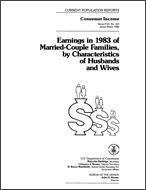Earnings in 1983 of Married-Couple Families, by Characteristics of Husbands and Wives
Earnings in 1983 of Married-Couple Families, by Characteristics of Husbands and Wives
Introduction
This report contains data on the annual earnings of husbands and wives and their combined earnings as married couples for 1983. This is the second report released by the Bureau of the Census on married couples with earnings. The first report contained data for 1981. Earnings data are presented using three important determinants of earnings levels: (1) annual work experience, (2) occupation, and (3) level of educational attainment. Earnings levels of husbands and wives by age and presence of children are presented and discussed, and a table has also been included showing the number and characteristics of wives having higher earnings levels than their husbands. The data in the report were obtained from the March 1984 Current Population Survey (CPS).
The main purpose of this report is to provide specialized data on earnings of husbands and wives that have, until now, not been available in the annual Current Population Reports, Consumer Income Series (P-60). The working wife has become an integral feature of the U.S. economy and an important influence on the economic level of the family. Perhaps because of greater job opportunities as well as higher levels of educational attainment, women are in a much better position to enter the labor market and supplement the family income. The 20-year period between 1963 and 1983 saw the annual average number of women in the labor force increase from 24.7 million to 48.6 million.1 The number of wives in the paid labor force in March 1964 increased from 13.4 million to 26.2 million in March 1984.2
It should be noted that the data in this report cover 1983, a year of economic recovery following the recession that ended during the latter part of 1982. This situation may have had some effect on the relationship between the earnings of husbands and wives. Differences between the earnings of husbands and wives result from a multitude of factors, and because we have covered only some of the major determinants of earnings in this report, comparisons of husbands and wives earnings levels cannot be used to examine issues such as possible sex discrimination and differences in the monetary gains from education. Also, husbands and wives are only a subset of all workers. These kinds of analyses should be based on more detailed statistics from persons with similar educational backgrounds, degrees, specific occupations, and previous lifetime work experience.
__________
1 U.S. Department of Labor, Bureau of Labor Statistics, Employment and Earnings, Volume 31, Number 4, April 1984.
U.S. Department of Labor, Bureau of Labor Statistics, Labor Force Statistics Derived from the Current Population Survey: A Databook, Volume 1, September 1982.
2 U.S. Bureau of the Census, Current Population Reports, Series P-60, Nos. 43 and 146.
A Note on Language
Census statistics date back to 1790 and reflect the growth and change of the United States. Past census reports contain some terms that today’s readers may consider obsolete and inappropriate. As part of our goal to be open and transparent with the public, we are improving access to all Census Bureau original publications and statistics, which serve as a guide to the nation's history.
Others in Series
Publication
Publication
Publication




